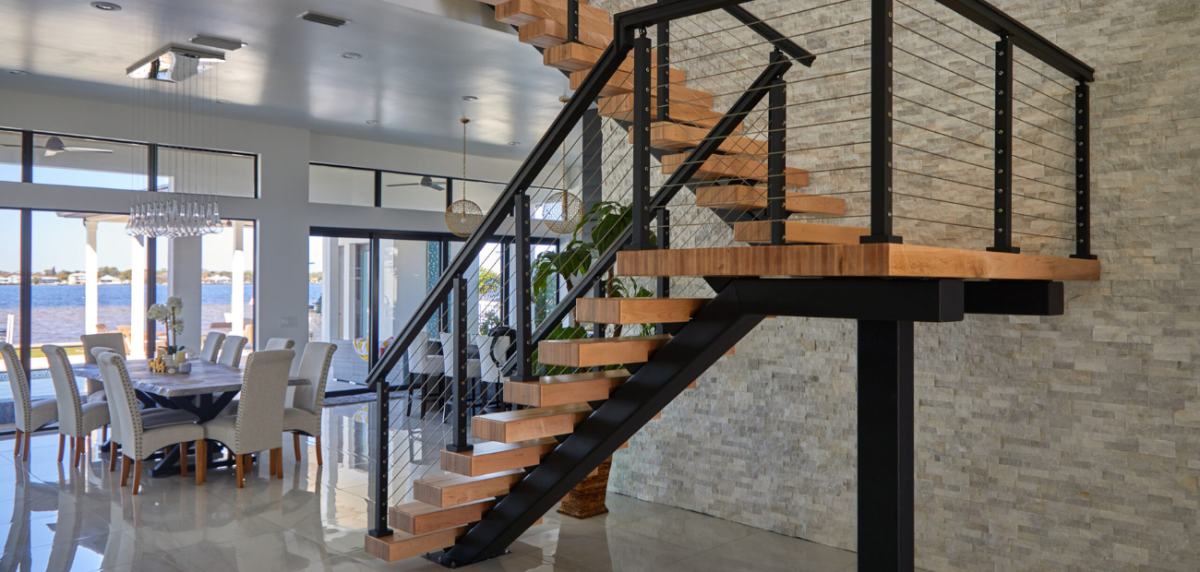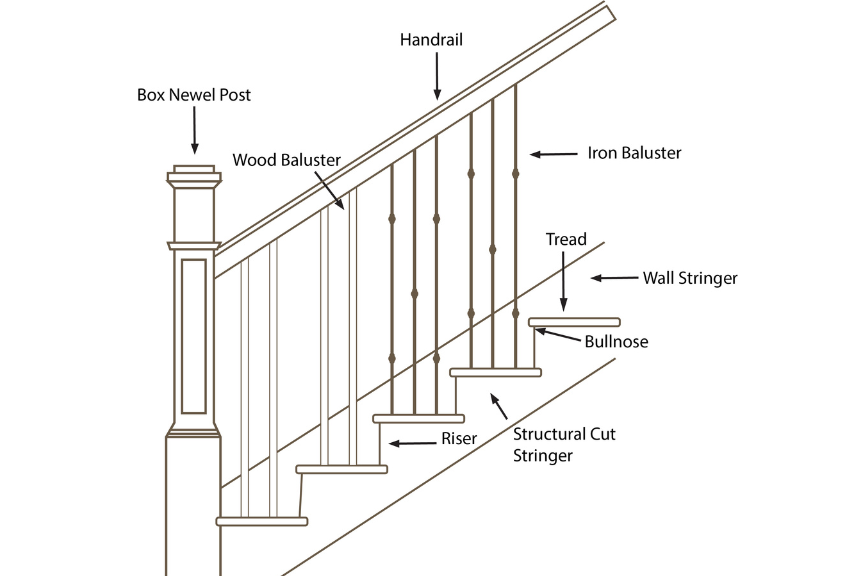Key Takeaways
- Stairs primarily offer function, but also provide an opportunity to make a statement as a three-dimensional sculpture.
- Homeowners should know that staircases, like most other parts of a home, can be renovated to suit desired tastes and styles.
- Nowadays, there’s no single way to decorate, renovate or style a staircase, which makes it a great feature for creativity in design.
Few homeowners turn down a house because of the style and construction of the stairway. That’s because they’re viewed more for their function.
Still, aesthetics make a difference, especially since stairways often act as a focal point. “A stair can become a vertical feature and very dramatic statement that reflects what’s to come,” says designer Tom Segal of Kaufman Segal Design. Architect Bob Zuber, AIA, Principal of Morgante Wilson Architects agrees and adds that it’s the most important three-dimensional object in most homes, “which offers an opportunity to make a sculptural statement.”
There’s no single way to construct and decorate a staircase. In a recent Elle Décor magazine, editor and homeowner Ingrid Abramovich installed a classic striped runner on the stairs of her family’s 1870s vintage brownstone. In the same issue, designer Darryl Carter included a sweeping curved stair with fully exposed pale wood treads in a client’s new Georgian Revival-style house in Washington, D.C. Both solutions meld function and style to fit each house.
Architect Alexander Zilberman, AIA, Principal, Alexander Zilberman Architecture P.C. (AZA), says that instead of having a stairway make a grand gesture within an entranceway, he likes to tuck it aside in its own space for its own identity. “Pilasters and soffits can help define such a space, and it can bleed into another yet live in its own area,” he says.
With extra attention, a stairway and its surroundings may help a sale by improving a buyer’s first impression, says broker Alicja Skibicki, Baird & Warner. “It’s not as important as a new kitchen or bathroom but can make a difference. Newer floating staircases can add a dramatic accent with sleek, clean lines, which younger buyers look for,” she says.
Consider Proportions
Hallways come in all shapes and sizes but what’s key is that the stairway be proportionate with the space around it. For safety, stair construction falls under building code rules in terms of riser height and tread width with some leeway. The goal when remodeling a stairway or building new is that climbing and descending a stairway should be a graceful journey, Zuber says. The parts—balustrade, railing, newel post and nose—should also be in proportion with one another. The Houzz design and remodeling site provides more guidelines to share, Key Measurements for a Heavenly Stairway.
Opt for Continuity
One of the trickiest decisions is to decide what color wood to use since some like having it compatible with exposed flooring, says Segal. “I advise clients to decide on their floor species and color first if they’re replacing it or restaining, and then proceed to the stairs and all its parts,” he says. “The wood or colors should match in stain color rather than be different,” he says.
Designers all have their favorites when it comes to color, shade and material. For instance, Segal favors walnut and oak for their durability and colors or stains in a darker or medium hue rather than light, but in cases of very contemporary homes he might pick a light stain, but not a whitewashed one.
Trends fall in and out of favor over time, so homeowners might want to consider more long-term factors—durability, desired aesthetic and the overall style of the home—instead.
Because so many of their clients favor a contemporary look, Zuber and colleagues use a lot of white oak with a light or pale stain and square off the nose—the part beyond the tread, which in the past was usually rounded. Zilberman prefers to make choices according to what’s happening throughout the house.
Mix It Up
While many staircases have wood balustrades and spindles to match, some designers like variety. Designer Marina Case of The Red Shutters often paints the handrail Farrow & Ball’s “Railings” (No. 31) color, which gives a blue-black appearance. Segal has often painted the risers and spindles white or a trim color to lighten the look. Although some consider wrought-iron railings in older homes dated, he may keep them if they’re not overly embellished. Zilberman finds that quality materials and the right joinery and other details are sufficient to play up the staircase.
Go Contemporary
For more contemporary-style homes, designers are introducing cable railings or glass walls on the outer side. Zuber says many clients favor these looks because they allow in more light and views. Janet Bertin, of Janet Bertin Decorating Den Interiors, added metal cable railing in a client’s traditional suburban home to update it. She paired the cable with oak treads stained a medium gray to match the flooring. She also made the risers white and ran a carpet runner in tightly woven blue wool. “The finished look helped to freshen what was an ordinary suburban home and for a fairly modest cost of about $15,000,” she says.
Designer Ioana Tzatcheva of Ioana Todorvoa Designs, Decorating Den Interiors, modernized the wood staircase in her suburban Colonial-style home by adding tempered glass panels and steel handrail and posts, all fabricated by a shower door company. “I wanted to make it a focal point and style statement,” she said. To match newly whitewashed floors throughout, stairs were capped with new white oak treads and risers.
Use Stair Modules
These days, many specialist stair companies build parts as modules off-site and assemble them in the house, which saves time and pares mistakes. That’s the case with Viewrail, which started out manufacturing traditional stair parts and has shifted to focusing on cable railings and glass walls. The company also manufactures floating staircases, which are certified for safety by the International Code Council.
The Rundown on Using Carpet (or Not)
Nowadays, it’s rare for a designer to favor fully carpeted treads. That said, runners still work in some cases. Depending on the wood designers find underneath, they may stain and finish the boards, paint them if they’re not in good shape and leave them showing or add a runner.
For safety, some professionals recommend wire-brushing stairs if left uncarpeted to avoid falls. But some like Zuber still prefer to leave most uncarpeted for a more modern look. Zilberman is also in the “no carpet” camp and feels if a stairway is done properly, it doesn’t need additional ornamentation and should be celebrated on its own.
Case, however, is among those who like adding a runner to avoid falls and buffer sounds. She favors flat, tight weaves in nylon or wool and classic patterns such as stripes or plaids.
If homeowners opt for adding carpet, an experienced installer is crucial to align patterns. Most runners, says designer Suzanne Wemlinger of Suzan J Designs, are installed in the waterfall method, where the carpet cascades down the stairs. Another option is the more expensive Hollywood or Chicago style where each stair and riser share a separate piece of carpet.
Add Accessories
Though a stairway often functions as its own statement, especially when in or near the foyer, homeowners might want to consider the surrounding space. Wallpaper, on a big comeback, or paint add color and style to the space surrounding the staircase. A large light relative to a foyer’s size can add more drama and set off a stairway, says Segal.
Other traditional additions: a table or chest, mirror, seating, artwork and area rug that repeats what’s on stairs or floor cloths that are easy to clean, Case says. Skibicki likes applying faux-wood panels along a stairwell to add texture. “But any additions are a good way to add individual style,” she says.

 Facebook
Facebook
 X
X
 Pinterest
Pinterest
 Copy Link
Copy Link







